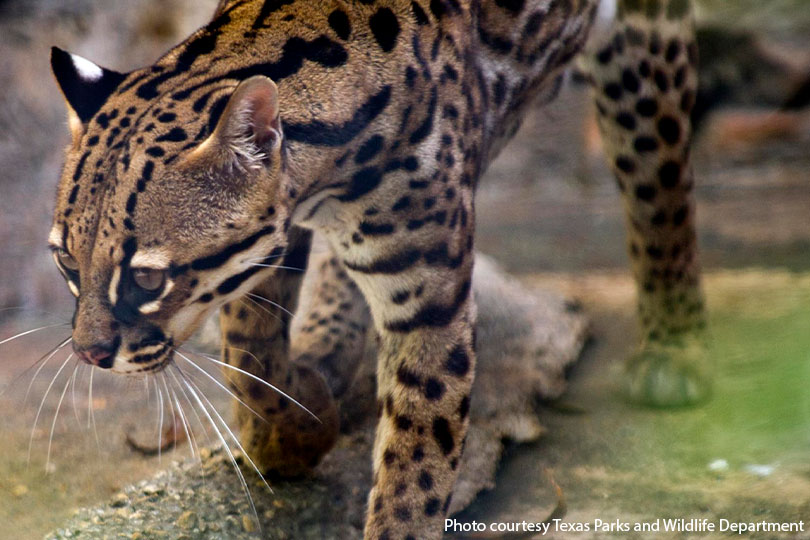By Jessica Domel
Multimedia Reporter
The public can weigh in on a proposal that would reintroduce endangered ocelots to areas of the Rio Grande Valley while protecting landowners in the area.
The proposed Programmatic Safe Harbor Agreement was developed by the East Foundation, a South Texas ranching operation and Agricultural Research Organization, with the U.S. Fish and Wildlife Service (FWS).
Under the agreement, the East Foundation agrees to release ocelots onto a portion of its San Antonio Viejo Ranch in Jim Hogg and Starr counties where unoccupied ocelot habitat has been identified.
“What a Safe Harbor Agreement does, particularly for private lands, is it takes away the fear that the Endangered Species Act is going to be enforced when you do good things,” Neal Wilkins, East Foundation CEO, said. “If we’re going to release ocelots into a new area, which we’ve proposed to do with the U.S. Fish and Wildlife Service, we don’t want to be held to the same constraints they would normally impose upon landowners for incidental take and conservation measures to maintain that population over time.”
The released ocelots will come from a breeding and behavioral program that will be established in Kingsville with the Caesar Kleberg Wildlife Research Institute and FWS.
“If it’s an experimental population, and we’re releasing ocelots into an area with the chance of creating a new population and really investing in that, we don’t want ourselves or any of our neighbors or any other ranchers in the nearby area to be constrained in their land-use activities,” Wilkins told the Texas Farm Bureau Radio Network. “The Fish and Wildlife Service allows that, but they only allow it if you go through a permitting process. That’s the Safe Harbor permitting process we’re going through right now.”
The foundation will continue its normal ranching activities on the San Antonio Viejo Ranch throughout the process.
“We’re a ranching enterprise, and we don’t want to do anything that would reduce our ability to carry out our animal agriculture and ranching operations,” Wilkins said. “By extension, we don’t want to do anything that would constrain any of our neighbors on any of their ranching operations or development for oil and gas or anything else.”
After the public comment period is over and the agreement is finalized, landowners near the ranch in Zapata, Jim Hogg, Brooks, Starr and Hidalgo counties will be able to participate in the Safe Harbor Agreement through a certificate of inclusion from the East Foundation.
“We have assurances that any landowners within 50 kilometers, which is 31 miles of the area where we reintroduce ocelots, are free to carry out any otherwise lawful activity regardless of whether ocelots have been dispersed onto their property or regardless of whether they join the Safe Harbor Agreement as a participant,” Wilkins said. “If some of the landowners want to, we can issue them a certificate of inclusion. That just simply means they’re still protected under the same protections as everybody else, but they’re participating in the restoration effort.”
This kind of work is necessary, Wilkins said, because the majority of Texas is privately-owned.
“The only way we can recover endangered species across private lands where they don’t exist is to just simply give those landowners an assurance they’re not going to be punished for carrying out good conservation measures and trying to recover an endangered species,” Wilkins said.
Ocelots have been listed as endangered in the United States since 1982.
The only remaining ocelot breeding population in the nation is in deep South Texas.
“Ocelots have a population in Texas of less than 150 but more than 100, and they’re isolated into two small populations along the Texas coast,” Wilkins said. “One we call the refuge population, and it’s around Laguna Atascosa National Wildlife Refuge.”
There are 16-20 ocelots on the refuge.
Further north, there are 60-80 ocelots centered around the East Foundation’s El Sauz Ranch, north of Port Mansfield.
“The largest population of ocelots remaining in Texas (and, by extension, the United States), occupies East Foundation ranch land in Willacy County,” Dr. Jason Sawyer, chief science officer for the East Foundation, said. “We have demonstrated that good land stewardship associated with normal ranching activities is not in conflict with ocelot recovery. We want to continue ranching operations while also providing an opportunity to expand these populations.”
The East Foundation has supported ocelot recovery and research for years.
“Historically, the research has focused in on how large their home range is, the habitats they use, prey availability, predator-prey relationships and those things you would study about a population,” Wilkins said. “More recently, we’ve begun work that’s a little more practically directed at restoration and recovery of ocelots, and that’s whether or not we can collect semen from male ocelots and impregnate female ocelots so that we can increase the genetic diversity and perhaps captively rear ocelots for release into the wild and help the genetics of the current population.”
Currently, the population of ocelots is so small, it’s likely that close relatives are breeding with one another.
“If we don’t correct that, then we’re going to end up in the same situation as the Florida panther was, where that population had decreased reproductive abilities and a lot of different kind of sicknesses,” Wilkins said. “We probably already have that within our current ocelot population. We just haven’t been able to document it.”
The public can comment on the East Foundation’s proposed Programmatic Safe Harbor Agreement through Oct. 16.
The proposal can be read here.
Comments may be submitted by clicking the blue “comment” button on this website.


Leave A Comment